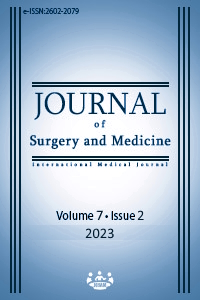Impact of COVID-19 fear on Hepatitis C management
Hepatitis C awareness during the pandemic
Keywords:
hepatitis C, management, pandemicsAbstract
Background/Aim: Hepatitis C virus (HCV) infection, a major cause of cirrhosis worldwide, is the most common cause of cirrhosis and hepatocellular carcinoma in Turkey. Today, HCV infection can be treated effectively and safely using direct-acting antiviral drugs, and therefore, the World Health Organization has announced elimination targets by 2030. During the pandemic, many social and personal restrictions were applied for fear of increasing the prevalence of coronavirus disease 2019 (COVID-19) infection. Here we investigate the effects of these restrictions on managing HCV infection in internal medicine departments that deal with both infections.
Methods: Patients who applied to the internal medicine departments of our hospital and tested for anti-HCV between 11 March 2020 and 09 April 2022, which was the time interval when official restrictions were applied in Turkey during the COVID-19 pandemic, were included in the study. Patients who were not tested for anti-HCV were excluded from the study. The study was planned as a retrospective cohort study, and patients’ files tested for anti-HCV were scanned. Anti-HCV positivity, HCV RNA PCR testing, and treatment status in HCV RNA-positive patients were evaluated.
Results: During the official pandemic period when social restrictions were applied, anti-HCV positivity was revealed in 400 (1.9%) of 21,501 patients for whom anti-HCV tests were performed in internal medicine departments. HCV RNA was not tested in 64 of 400 patients with positive anti-HCV test (16%), and 83 (24.7%) of 336 patients tested for HCV RNA were found to be positive. It was determined that 17 (20.5%) of the HCV RNA-positive patients did not receive antiviral treatment.
Conclusion: In studies conducted in Turkey in the pre-pandemic period, it was determined that HCV RNA was not tested in approximately half of the anti-HCV-positive patients, while this rate was found to be only 16% during the pandemic period. This can be explained by the fact that patients infected with the COVID-19 virus were mostly followed-up by internal medicine clinics, where the awareness of viral hepatitis was high. It was determined that 20.5% of the patients with positive HCV RNA PCR tests remained untreated. This finding suggested that the social and personal restrictions applied during the pandemic led to patient follow-up and treatment disruptions.
Downloads
References
Blach S, Zeuzem S, Manns M, Altraif I, Duberg AS, Muljono DH, at al. Global prevalence and genotype distribution of hepatitis C virus infection in 2015: a modelling study. The Lancet Gastroenterology & Hepatology. 2017;2(3):161-76. DOI: https://doi.org/10.1016/S2468-1253(16)30181-9
Manns MP, Buti M, Gane E, Pawlotsky JM, Razavi H, Terrault N, at al. Hepatitis C virus infection. Nat Rev Dis Primers. 2017;3(1):17006.1-19. DOI: https://doi.org/10.1038/nrdp.2017.6
Kim D, Li AA, Perumpail BJ, Gadiparthi C, Kim W, Cholankeril G, et al. Changing Trends in Etiology-Based and Ethnicity-Based Annual Mortality Rates of Cirrhosis and Hepatocellular Carcinoma in the United States: Hepatology. Hepatology. 2019;69(3):1064-74. DOI: https://doi.org/10.1002/hep.30161
Barut HŞ, Günal Ö. Dünyada ve Ülkemizde Hepatit C Epidemiyolojisi. Klimik Dergisi. 2009;22(2):38-43.
Tozun N, Ozdogan O, Cakaloglu Y, Idilman R, Karasu Z, Akarca U, et al. Seroprevalence of hepatitis B and C virus infections and risk factors in Turkey: a fieldwork TURHEP study. Clinical Microbiology and Infection. 2015;21(11):1020-6. DOI: https://doi.org/10.1016/j.cmi.2015.06.028
Idilman R, Aydogan M, Oruncu MB, Kartal A, Elhan AH, Ellik Z, et al. Natural History of Cirrhosis: Changing Trends in Etiology Over the Years. Dig Dis. 2021;39(4):358-65. DOI: https://doi.org/10.1159/000512746
Alter MJ, Gao F. The Prevalence of Hepatitis C Virus Infection in the United States, 1988 through 1994. The New England Journal of Medicine. 1999;341(8):556-62. DOI: https://doi.org/10.1056/NEJM199908193410802
Conry-Cantilena C, VanRaden M, Gibble J, Melpolder J, Shakil AO, Viladomiu L, et al. Routes of Infection, Viremia, and Liver Disease in Blood Donors Found to Have Hepatitis C Virus Infection. N Engl J Med. 1996;334(26):1691-6. DOI: https://doi.org/10.1056/NEJM199606273342602
Yano M, Kumada H, Kage M, Ikeda K, Shimamatsu K, Inoue O, et al. The long-term pathological evolution of chronic hepatitis C. Hepatology. 1996;23(6):1334-40. DOI: https://doi.org/10.1002/hep.510230607
Seeff LB, Miller RN, Rabkin CS, Buskell-Bales Z, Straley-Eason KD, Smoak BL, et al. 45-Year Follow-up of Hepatitis C Virus Infection in Healthy Young Adults. Ann Intern Med. 2000;132(2):105-11. DOI: https://doi.org/10.7326/0003-4819-132-2-200001180-00003
Poynard T, Bedossa P, Opolon P. Natural history of liver fibrosis progression in patients with chronic hepatitis C. The Lancet. 1997;349(9055):825-32. DOI: https://doi.org/10.1016/S0140-6736(96)07642-8
Tampaki M. Extrahepatic immune related manifestations in chronic hepatitis C virus infection. WJG. 2014;20(35):12372-80. DOI: https://doi.org/10.3748/wjg.v20.i35.12372
EASL Recommendations on Treatment of Hepatitis C 2016. Journal of Hepatology. 2017;66(1):153-94. DOI: https://doi.org/10.1016/j.jhep.2016.09.001
AASLD-IDSA HCV Guidance Panel, Chung RT, Ghany MG, Kim AY, Marks KM, Naggie S, et al. Hepatitis C Guidance 2018 Update: AASLD-IDSA Recommendations for Testing, Managing, and Treating Hepatitis C Virus Infection. Clinical Infectious Diseases. 2018;67(10):1477-92. DOI: https://doi.org/10.1093/cid/ciy585
Roudot-Thoraval F. Epidemiology of hepatitis C virus infection. Clinics and Research in Hepatology and Gastroenterology. 2021;45(3):101596.1-6. DOI: https://doi.org/10.1016/j.clinre.2020.101596
Waheed Y, Siddiq M, Jamil Z, Najmi MH. Hepatitis elimination by 2030: Progress and challenges. WJG. 2018;24(44):4959-61. DOI: https://doi.org/10.3748/wjg.v24.i44.4959
Pawlotsky JM. Treatment failure and resistance with direct-acting antiviral drugs against hepatitis C virus. Hepatology. 2011;53(5):1742-51. DOI: https://doi.org/10.1002/hep.24262
Denniston MM, Klevens RM, McQuillan GM, Jiles RB. Awareness of infection, knowledge of hepatitis C, and medical follow-up among individuals testing positive for hepatitis C: National Health and Nutrition Examination Survey 2001-2008. Hepatology. 2012;55(6):1652-61. DOI: https://doi.org/10.1002/hep.25556
Daniş N, Arslan A, Buyruk M, Günşar F, Zeyti̇Noğlu A, Altuğlu İ, et al. Cerrahi prosedürler öncesi anti-HCV taraması: Hastalar yeterince bilgi sahibi mi? Akademik Gastroenteroloji Dergisi. 2021;20(1):8-12. DOI: https://doi.org/10.17941/agd.930893
Balaban HY, Dağ O, Alp A, Tseveldorj N, Vahabov C, Göktaş MA, et al. Retrospective Evaluation of Hepatitis C Awareness in Turkey Through Two Decades. Turk J Gastroenterol. 2021;32(1):88-96. DOI: https://doi.org/10.5152/tjg.2020.19949
Wang W, Sun L, Liu T, Lai T. The use of E-health during the COVID-19 pandemic: a case study in China’s Hubei province. Health Sociology Review. 2022;31(3):215-31. DOI: https://doi.org/10.1080/14461242.2021.1941184
Downloads
- 418 524
Published
Issue
Section
How to Cite
License
Copyright (c) 2023 Ufuk Avcıoğlu, Mehmet İhsan Başkaya
This work is licensed under a Creative Commons Attribution-NonCommercial-NoDerivatives 4.0 International License.
















